
|
 |
 |
Discoveries in the Deep A Chronology of Undersea Exploration
Sir John Ross lowers a line more than a mile into the North Atlantic and hauls up worms and a large sea star. 1843 Edward Forbes proposes that no substantial life can exist below three hundred fathoms. 1858 The first transatlantic telegraph cable comes to life, its laying preceded by deep seabed surveys. 1859 Darwin's Origin of Species implies that the deep is a sanctuary for living fossils. 1864 Norwegians haul up from the deep a sea lily, a living fossil previously found only in rocks 120 million years old. 1870 Jules Verne's Twenty Thousand Leagues Under the Sea depicts no life in the ocean's deepest regions. 1872-76 British ship Challenger sails the globe while lowering dredges and other gear into the deep, finding long mountain chains, puzzling nodules, and hundreds of animals previously unknown to science.
Prince Albert of Monaco starts to probe the sea's dark midwaters, discovering new kinds of eels, fish, and squid. 1920 Alexander Behm sails the North Sea and bounces sound waves off its bottom, advancing a new method of depth measurement known as echo sounding. 1925 Fritz Haber launches the German Meteor expedition in a bid to extract gold from seawater. 1934 William Beebe and Otis Barton descend in a tethered sphere to a depth of a half mile, where they glimpse a previously unseen world of living lights and bizarre fish. 1938 Fishermen off South Africa pull up an ungainly five-foot fish identified as a coelacanth, a living fossil thought extinct since the days of the dinosaurs.
Auguste Piccard dives in his bathyscaph, the first untethered craft that carried people into the deep. 1950-52 Danish ship Galathea lowers dredges into the sea's deepest trenches and hauls up swarms of invertebrates. 1951 British ship Challenger II bounces sound off the bottom, and near Guam finds what appears to be the sea's deepest chasm, its lowest point nearly seven miles down, subsequently named the Challenger Deep. 1952 Marie Tharp, studying echo soundings, discovers that the Mid-Atlantic Ridge conceals a long rift valley, which turns out to be part of a hidden volcanic rent that girds the global deep.
Auguste Piccard and his son Jacques enter Trieste, an improved bathyscaph, and dive to a depth of nearly two miles. 1958 American Navy buys Trieste and begins to strengthen its steel personnel sphere. 1960 Jacques Piccard and Don Walsh dive in Trieste to bottom of Challenger Deep, seven miles down. 1961 American ship off Mexico lowers a pipe through more than two miles of water and drills into the rocky seabed, a first that advances the fields of deep geology and mining. Robert Dietz, studying echo soundings, proposes that the seabed's mountainous rifts are invisible scars where molten rock from the Earth's interior wells up periodically and spreads laterally to form new ocean crust, a process he calls seafloor spreading.
Thresher, America's most advanced submarine, sinks in waters a mile and a half deep with the loss of 129 men. Trieste finds the shattered hulk of Thresher on the bottom after five months of searching. 1964 American Navy founds the Deep Submergence Systems Project to develop new gear that can better probe the deep sea's darkness. Navy launches submersible Alvin, the first piloted craft able to roam the deep with relative ease.
Navy tests its first underwater robot. Navy develops Halibut, a submarine that can lower miles of cables bearing lights, cameras, and other gear to spy on enemy armaments and materiel lost on the bottom of the sea. 1966 Alvin and Navy robot probe the deep Mediterranean and retrieve a lost American hydrogen bomb. Halibut spies on Soviet warheads abandoned to the deep. Continue: 1967 The Mission | Life in the Abyss | The Last Frontier | Dispatches E-mail | Resources | Table of Contents | Abyss Home Editor's Picks | Previous Sites | Join Us/E-mail | TV/Web Schedule About NOVA | Teachers | Site Map | Shop | Jobs | Search | To print PBS Online | NOVA Online | WGBH © | Updated October 2000 |
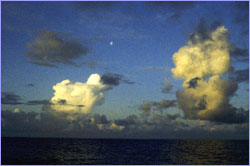 Pacific Ocean above Juan de Fuca Ridge.
Pacific Ocean above Juan de Fuca Ridge.
 The 'Pompeii' tubeworm, Alvinella pompejana.
The 'Pompeii' tubeworm, Alvinella pompejana.
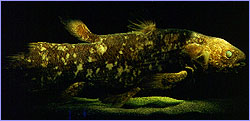 Coelacanth, the 'fossil fish'.
Coelacanth, the 'fossil fish'.
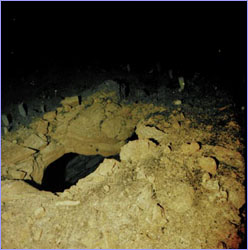 Vent in the ocean floor.
Vent in the ocean floor.
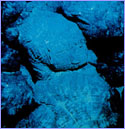 Lava mound on the East Pacific Rise.
Lava mound on the East Pacific Rise.
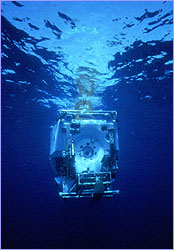 The submersible Alvin on duty.
The submersible Alvin on duty.